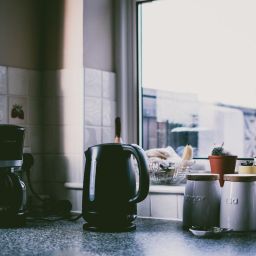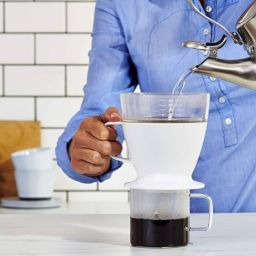
The coffee press, often referred to as a French press, stands out in the coffee world for its simplicity and the exceptional cup of joe it delivers. This beloved method brews coffee by steeping grounds in hot water, then pressing them away, making it a go-to for coffee enthusiasts seeking a rich and full-flavored experience. Its ease of use and ability to extract deep flavors have cemented the coffee press’s popularity among daily drinkers and connoisseurs alike.
Key Takeaways
- Better Aroma Compared to Drip Coffee: The steeping process of a coffee press ensures a more vibrant aroma, setting it apart from the quicker, run-over methods of traditional coffee machines.
- More Convenient Pouring, Reducing Spills: Its design minimizes morning mishaps, making pouring a smooth, spill-free experience.
- Brews at the Optimal Temperature: At around 195°F, a coffee press hits the sweet spot for temperature, extracting rich flavors without bitterness.
- Eliminates Impurities: A coffee press provides a cleaner cup by avoiding impurities, especially when paired with high-quality beans.
- Enhances Morning Routines: The ritual of preparing coffee with a press can add a peaceful, meditative element to start your day.
- Stylish Addition to Kitchen Decor: Beyond its brewing capabilities, a coffee press is also a chic accessory for any kitchen.
Flavor and Aroma
A coffee press doesn’t just make coffee; it unlocks a world of flavor and aroma that other brewing methods struggle to match. The key lies in its brewing process, which allows coffee grounds to fully steep in hot water. This method ensures that all the essential oils and subtle flavors trapped inside the coffee grounds are extracted into your cup. Unlike drip coffee makers that often rush hot water through the grounds, a coffee press gives these flavors the time they need to bloom, leading to a cup that’s not just coffee but an experience.
Control Over Brewing Process
One of the most cherished aspects of using a coffee press is the control it offers over the brewing process. You decide the water temperature and the brewing time, tailoring each cup to your personal taste. If you prefer a stronger cup, simply let the coffee steep a little longer. If you’re in the mood for something lighter, shorten the steep time. Adjusting the water temperature is another tool at your disposal; brewing at about 195°F to 200°F is ideal for extracting the coffee’s full spectrum of flavors without bitterness.
Health Benefits
When you brew coffee in a press, you’re doing more than just making a cup of coffee; you’re extracting a brew rich in flavors and, potentially, health benefits. This brewing method allows essential oils from the coffee grounds to blend into your cup, oils that are often trapped or filtered out by traditional drip or paper-filter methods. These oils contain natural compounds that can contribute to your well-being, including antioxidants that combat inflammation and protect your cells from damage.
The presence of these oils can make your morning cup not just a source of caffeine but a subtle booster for your health. While it’s important to enjoy coffee in moderation, the unique extraction process of a coffee press might just give your daily ritual an extra layer of benefit.
Economic and Environmental Benefits
Opting for a coffee press has noticeable advantages for both your wallet and the planet. Economically, a coffee press is a one-time purchase that can last for years with proper care, bypassing the ongoing costs associated with buying paper filters or capsules required by other brewing methods. Over time, this adds up to significant savings, making the coffee press an excellent choice for those looking to enjoy great coffee without ongoing expenses.
From an environmental standpoint, the coffee press stands out as a greener option. By eliminating the need for disposable filters and plastic pods, it significantly reduces waste. Consider the millions of coffee pods and paper filters that end up in landfills each year; switching to a coffee press can be a small but impactful step towards reducing that number.
Moreover, the simplicity and durability of a coffee press mean less manufacturing and less material waste over its lifetime compared to the often complex and less durable pod-based machines.
How to Use A Coffee Press: A Step-by-Step Guide
Brewing the perfect cup with a coffee press is an art that’s easy to master with just a little practice. Here’s how to get started on your journey to a better cup of coffee.
1. Select Your Coffee Beans: Choose fresh, whole bean coffee for the best flavor. The fresher the beans, the more flavorful your coffee will be. When it comes to grind size, aim for a medium to coarse grind. Too fine, and you’ll end up with a bitter cup and a clogged filter; too coarse, and your coffee will be weak.
2. Preheat Your Coffee Press: Before adding your coffee, pour hot water into the press to warm it up. This helps maintain the temperature during the brewing process, ensuring your coffee extracts evenly. Just make sure to discard this water before adding your coffee grounds.
3. Measure Your Coffee: A good rule of thumb is to use one ounce (28 grams) of coffee per 16 ounces (about 475 milliliters) of water. Adjust to taste, but this ratio is a solid starting point for a balanced cup.
4. Heat Your Water: The ideal brewing temperature for coffee is around 200°F (about 93°C). If you don’t have a thermometer, bring the water to a boil and then let it sit for about 30 seconds. This should bring it down to the right temperature range.
5. Combine and Stir: Add your coffee grounds to the press, then add the hot water. Give the mixture a gentle stir to ensure all the grounds are wet and begin extracting.
6. Let It Brew: Place the lid on the press with the plunger pulled up and let the coffee brew for about 4 minutes. This brewing time allows for full flavor extraction without over-extracting, which can make the coffee bitter.
7. Press Down Slowly: After brewing, press the plunger down slowly and steadily. Pressing too quickly can cause hot water and fine grounds to shoot up the spout, resulting in a messy cup.
8. Serve Immediately: Coffee from a press should be enjoyed right away. Letting it sit can lead to over-extraction, making the last cup much stronger and potentially bitter compared to the first.
FAQs
Can you use any coffee in a French press?
Absolutely! While you can use any coffee for a French press, opting for a medium coarse grind is best. This ensures optimal extraction and keeps those pesky grounds out of your cup.
Can you use pre-ground coffee in a French press?
Yes, you can use pre-ground coffee, provided it’s the right coarseness. Medium coarse is ideal for a French press to work its magic properly.
How do you dispose of coffee grounds from a French press?
It’s best to throw them in the trash or add them to your compost pile. Washing them down the drain might lead to clogs, so it’s good practice to dispose of them more thoughtfully.
Can you make cold brew coffee in a French press?
Indeed! A French press can be a great tool for making cold brew. Just steep your coffee grounds in cold water for about 12 hours in the fridge, and you’re set for a refreshing drink.
Final Thoughts
The journey through the world of coffee presses reveals a path to brewing that’s as rich in flavor as it is in aroma. With a coffee press, you’re not just making coffee; you’re crafting an experience. This method allows for full extraction of your coffee’s oils and flavors, giving you a cup that’s simply unparalleled by other brewing methods.








